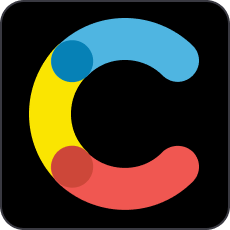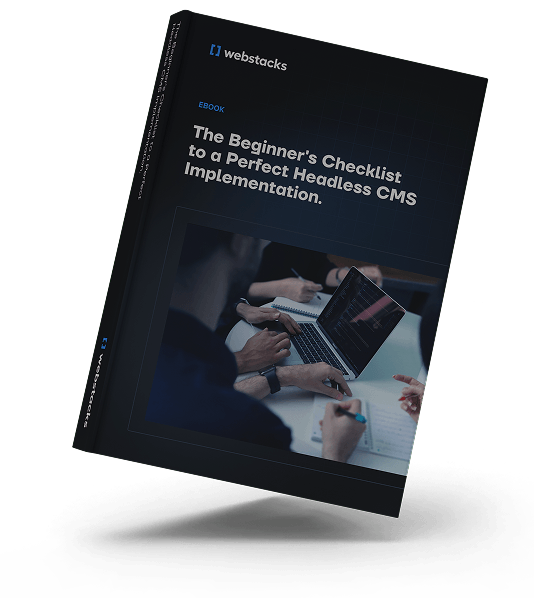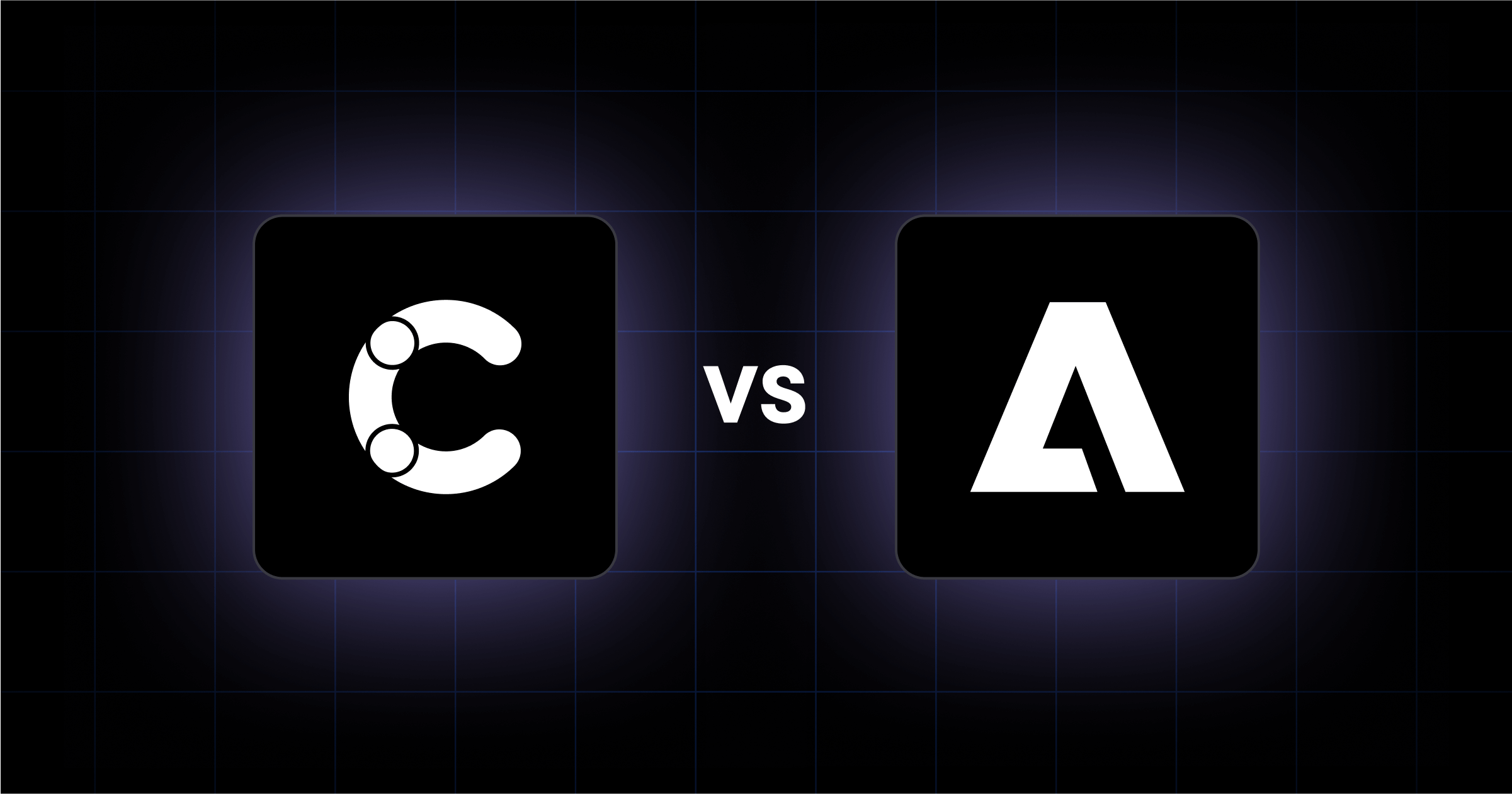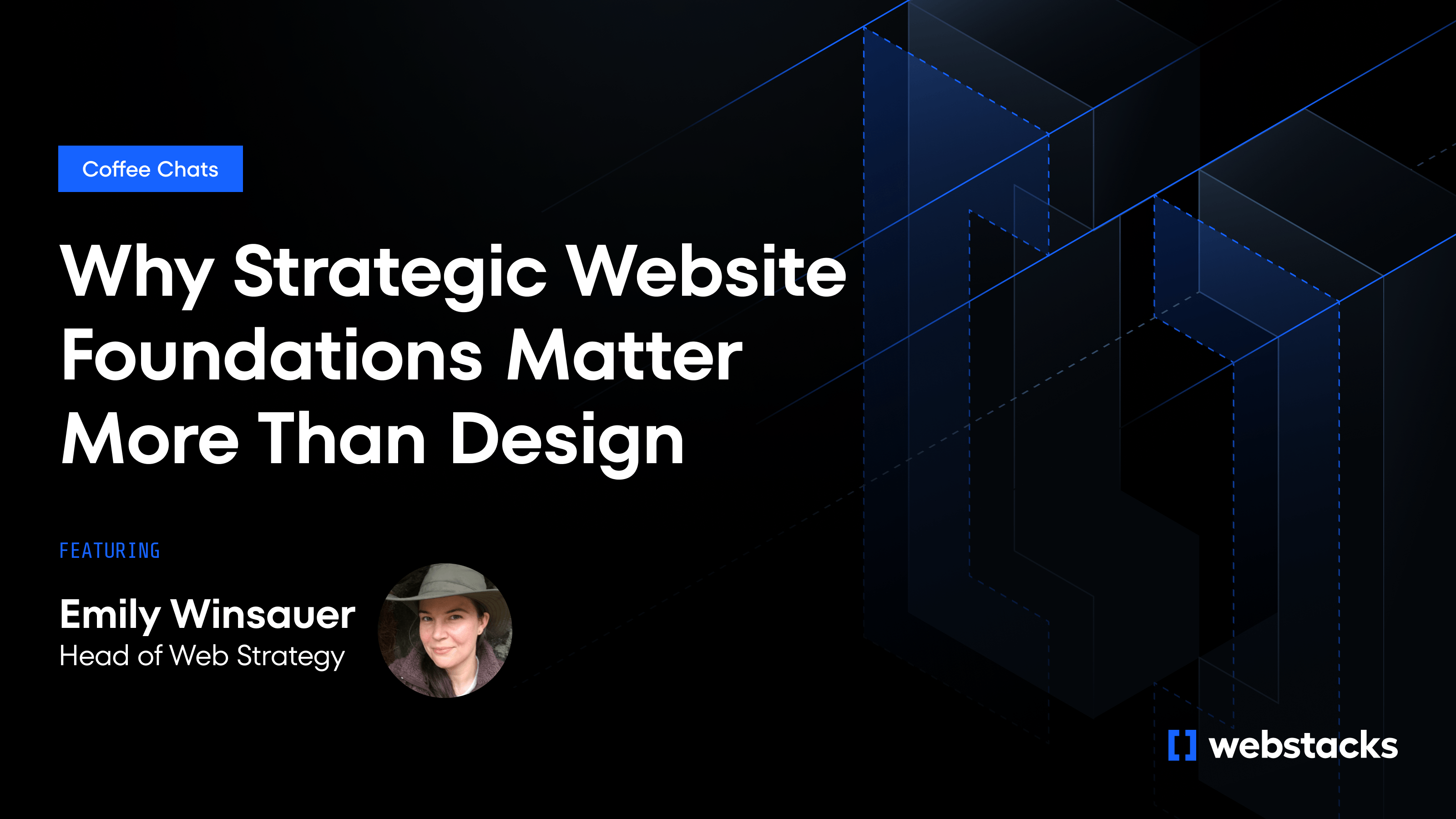Your content management system shapes how fast your team can move, how consistent your brand appears across channels, and how well your digital strategy scales.
When comparing Contentful vs AEM (Adobe Experience Manager), the question is which one gives your team the flexibility, speed, and control to drive growth.
At Webstacks, we’ve worked with dozens of high-growth B2B companies to help them evaluate and implement CMS platforms that support their marketing goals. While both Contentful and AEM are powerful in their own right, they’re built for very different teams, stacks, and stages of growth.
In this guide, we’ll break down how each platform fits into real-world workflows, team structures, and tech stacks, so you can confidently decide which CMS aligns best with your next stage of growth.
Contentful vs AEM at a Glance
Before diving into workflows and integrations, it’s helpful to understand how differently these platforms are designed and who they’re built for.
Contentful
- Headless, API-first CMS built for composable architecture
- Prioritizes flexibility, speed, and omnichannel delivery
- Designed for modern development teams working alongside agile marketing teams
- Lightweight, modular, and quick to implement
- Plays well with tools like Vercel, Segment, and HubSpot

AEM (Adobe Experience Manager)
- Enterprise-grade digital experience platform with a broad feature set
- Built to manage complex content workflows at scale, often across dozens or hundreds of sites
- Integrates with other Adobe tools (like Target, Analytics, and Creative Cloud)
- Offers visual page-building, personalization, and asset management
- Requires more time, budget, and technical specialization to implement
If you’re leaning toward composability, flexibility, and faster time-to-market, Contentful likely aligns better with your roadmap. But if you’re a large organization deeply embedded in Adobe’s ecosystem and managing complex governance, AEM might be worth the investment.
How Contentful and AEM Impact Your Marketing Team
Here’s how Contentful and AEM compare when it comes to everyday content operations.
Contentful Offers More Autonomy and Faster Execution
Contentful gives marketers a clean, structured interface that separates content from design. This means your team can focus on messaging, not layouts, and push updates across multiple channels easily.
- Marketers work with reusable content blocks, reducing the need to tap developers for every landing page or headline tweak
- Content is created once and published everywhere: web, app, digital signage, or email
- Custom roles and permissions keep things safe, while giving non-technical users freedom to work independently
For B2B marketing teams juggling campaigns, product updates, and site refreshes, Contentful’s simplicity and speed are huge advantages.
AEM Provides Structure and Governance at Scale
AEM is built for enterprise environments where compliance, oversight, and consistency are critical. Its WYSIWYG editor gives marketers visual control over pages, but the platform’s power lies in its governance features.
- Sophisticated approval workflows and publishing controls help large teams maintain oversight
- Drag-and-drop layout tools make it easier to build pages visually, but often within a more locked-down system
- It’s designed for companies managing multiple brands or global teams with complex permission structures
If your marketing team needs flexibility and speed, AEM can feel heavy. But if governance is your top priority, AEM offers the structure to manage risk at scale.
If your're already on AEM and considering migrating to a headless CMS, our next section should help you identify which architecture (traditional vs headless) is best for your business.
Landing Pages, Campaigns, and Speed-to-Market
For B2B teams running frequent campaigns, product launches, and landing page experiments, the ability to move quickly is a must. The CMS you choose can either unlock that agility or slow it to a crawl.
With Contentful, marketing and development teams typically align around reusable content components. Developers build flexible modules up front, and marketers use those components to spin up landing pages without needing custom code every time.
This modular approach makes launching campaign pages faster and more repeatable. While more complex layouts may still require a developer, most teams find that they can get most of the way on their own, without waiting on engineering backlogs.
AEM, on the other hand, offers a powerful page-building environment with visual, drag-and-drop controls.
For larger organizations with dedicated web production teams or brand managers, this gives marketers more control over layout without relying on external tools. That said, the same robustness that makes AEM appealing to global enterprises can also create friction. Initial setup is more involved, and workflows tend to be more structured, meaning campaign speed often depends on how streamlined your internal processes are.
If you’re launching campaigns weekly and need to move quickly with a lean team, Contentful’s modular architecture and developer-marketer handoff model will likely feel lighter and more agile. If you’re supporting a global marketing operation with brand governance at the forefront, AEM’s all-in-one experience may give you the guardrails you need.
5 Use Cases Where AEM and Contentful Perform Well
Here are five common use cases that reveal where Contentful and AEM do a great job.
1. Fast-Moving Teams Launching at Speed
If your company is in growth mode and rapidly launching new products, entering new markets, or running frequent experiments, Contentful gives your team the agility to iterate quickly.
For instance, Justworks partnered with Webstacks to implement a scalable design system, refactor their Contentful CMS, and quickly ship new web experiences. This modular approach makes launching campaign pages faster and more repeatable.
Contentful is especially well-suited for businesses building composable stacks using tools like Next.js and Vercel.
2. Enterprises Managing Complex Site Structures
AEM is a great choice when scale and governance are the most important factor. If you’re managing dozens or even hundreds of websites across regions, products, or business units, AEM offers powerful site inheritance, user roles, and publishing workflows that help maintain order and brand consistency.
Large enterprises in regulated industries often choose AEM for its built-in governance and permissions infrastructure.
3. Personalization at Scale
AEM’s tight integration with Adobe Target and Adobe Analytics makes it a go-to choice for companies focused on delivering personalized experiences.
Whether you're tailoring messaging by region, persona, or funnel stage, AEM allows you to manage and scale personalization directly within the platform.
Contentful supports personalization through third-party integrations but typically requires more custom development.
4. Omnichannel Content Delivery
For companies creating content across multiple digital channels, Contentful’s headless approach offers a lot of flexibility. We've seen B2B teams centralize their content in Contentful, then deliver it to everything from marketing sites to customer dashboards.
5. Organizations Deep in the Adobe Ecosystem
If your team already relies on Adobe products like Creative Cloud, Campaign, or Analytics, AEM becomes a natural fit. It connects with Adobe’s suite of tools, allowing content, assets, and data to flow efficiently across your marketing operations. This ecosystem advantage is one of the platform’s strongest selling points for enterprise teams.
How Contentful and AEM Impact the Developer Experience
The CMS you choose will shape your development workflows just as much as your marketing ones.
Contentful is Lightweight, Modern, and Easy to Extend
Developers love Contentful because it gets out of the way. You build your own frontend, define your own workflows, and have full control over how content is structured and rendered:
- API-first design makes content easily accessible via REST and GraphQL
- Supports modern frameworks like Next.js, Nuxt, and React out of the box
- Low setup complexity and is ideal for lean engineering teams
- Offers version-controlled content modeling and environments
- Pairs well with CI/CD pipelines, Vercel, and Netlify
AEM is Powerful but Demands Expertise
AEM gives you granular control and deep functionality, but it’s not lightweight. For teams with experienced AEM architects and a complex enterprise stack, it can be a great solution. For smaller or fast-moving teams, that complexity can slow progress.
AEM is:
- Deeply integrated with Adobe tools, but requires specialized skills
- Supports both on-prem and cloud deployments (AEM as a Cloud Service)
- Steep learning curve, especially for teams new to the Adobe ecosystem
- Best suited for enterprise IT teams with dedicated AEM developers
- Allows for highly customized workflows, but often with more effort
How AEM and Contentful Influence Scaling and Performance
Both Contentful and AEM are designed to scale, but the way they approach performance, infrastructure, and global delivery is fundamentally different.
Contentful is Cloud-Native and Composable from Day One
Contentful is especially suited for companies that want to scale fast without managing infrastructure. Whether you’re adding more regions, more users, or more channels, it adapts with minimal lift. Contentful is:
- Built on a microservices architecture with a global CDN for content delivery
- Designed to scale automatically with your traffic, no infrastructure management needed
- Supports content reuse across markets, languages, and channels
- Ideal for businesses growing quickly across digital platforms and geographies
- 99.9% uptime SLA and automatic updates minimize ops overhead
AEM Offers Enterprise Control, with Enterprise Complexity
For enterprises that require tight control, extensive compliance, or need to support dozens of global websites, AEM delivers. But scaling it effectively often means dedicating IT and dev resources long-term.
Note the following:
- AEM can be deployed on-premise or in the cloud (via AEM as a Cloud Service)
- On-prem option gives full control, at the cost of infrastructure overhead
- Cloud version supports autoscaling and global delivery, but requires more upfront configuration
- Built to support large content teams, multiple websites, and regulated industries
- Offers strong support for localization, permissions, and enterprise-grade compliance
When to Choose Contentful vs AEM
Here's when we typically recommend each platform based on team structure, tech stack, and long-term goals.
Choose Contentful if...
- Your marketing team needs to move fast without relying on developers for every update
- You’re building with a modern, composable tech stack (Next.js, Vercel, Segment, etc.)
- You’re scaling across multiple channels and need centralized, API-delivered content
- You want flexibility without the overhead of an enterprise suite
- Your organization prefers best-of-breed tools over all-in-one platforms
- You're looking for faster time-to-value and a more predictable cost model
Choose AEM if...
- You’re a large enterprise with complex governance, compliance, or localization requirements
- Your content operations span dozens of websites and business units
- You’re already invested in Adobe’s ecosystem (Analytics, Target, Creative Cloud)
- You need robust, native personalization and asset management features
- You have the resources (budget and dev talent) to support a complex rollout
- You want a unified suite for content, data, and design under one vendor
Exploring Other CMS Options?
Not sure if Contentful or AEM is the right fit? Many teams evaluating CMS platforms are also considering alternatives that balance flexibility, scalability, and ease of use in different ways.
Here are a few other platforms worth exploring based on common B2B content challenges:
- Sanity: A developer-first CMS ideal for teams that need deeply customized content models and flexible editorial workflows.
- Builder.io: Built for marketers who need complete visual control over content and layout, without developer dependency.
- Webflow: A great option for small to mid-sized teams that want to manage content and design in one place, typically for simpler marketing sites.
- Sitecore: A robust enterprise solution often compared to AEM, with powerful personalization and content governance capabilities.
Want to keep comparing? Check out:
At Webstacks, we help teams evaluate and implement the CMS that fits their current needs and their future growth. If you’re still mapping out your options, we’re happy to help.
Choose the CMS That Supports How Your Team Works
For many of the B2B companies we work with, the CMS decision comes down to breaking free from the limitations of a traditional CMS.
If your team is still relying on a monolithic platform that slows down launches, creates bottlenecks, or limits how your content is reused, now is the time to rethink your foundation.
Contentful offers speed, flexibility, and a truly headless, composable model. It’s ideal for teams that want to scale digital experiences without being locked into a single vendor.
AEM delivers deep functionality and control, especially for enterprises with complex workflows and heavy investments in the Adobe ecosystem.
Webstacks has helped dozens of teams migrate from traditional CMS platforms to modern, scalable platforms like Contentful and AEM. If you're planning a transition, we've created a step-by-step guide to help you do it right.





